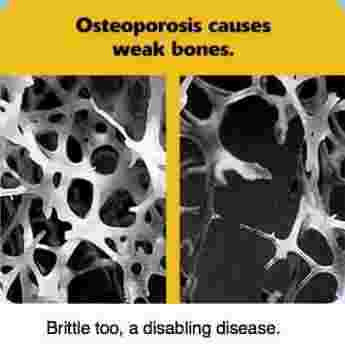Diabetes osteoporosis
Diabetes osteoporosis takes a look at this serious but preventable disease.
The WHO declares that in 1980 there were 108 million adult folk suffering from diabetes; today it is over 420 M. That is nearly ten-percent of the world's population; and increasing fast.
Type 2 DM is a disease that can be prevented but once established is very difficult to manage. It becomes an expensive and painful disaster. Perhaps even worse is how disabling it is.
Many folk rate disability even higher than pain; no longer able to walk or garden, or even drive to the supermarket has huge consequences.
Type I has long been known to be associated with bone loss. In women, for example, there is a much higher rate of hip fracture compared to non DM. How long you have had the disease is a major factor.
Women who have had type I for more than five years are a massive 12 times more likely to have a hip fracture than those without the ailment. Both low bone mineral density and the collagen protein matrix are clearly complications.
Of great concern is new research reported in the May 2014 journal of the American Medical Association which reveals that there has been a twenty one percent increase in type one in the American youth in only eight years. This affects all those treating bone and joint conditions, including obviously chiropractors.
I was recently walking with a poorly-controlled teenage type I when the girl missed a step and fell headlong. She simply never saw the curb; I suspect the early loss of peripheral vision associated with the retinopathy of this now common illness.

Diabetes osteoporosis
Diabetes osteoporosis can be ameliorated but once established is very difficult to manage; prevention is definitely better than the non-existent cure.
Obviously thus children who have type one diabetes are particularly vulnerable. They aren’t going to have the disease for only about 5 years. They will suffer from it for five or more decades. In particular since they are usually less than 20, whilst they are still building up their calcium, they may never reach adequate bone-density.
These fractures, of course, are not merely the result of diabetic osteoporosis, or weak bone structure. Diabetics are also prone to a variety of conditions like cataracts, for example, that increase the number of falls because of poor eyesight.
Diabetics also frequently have an altered gait; changes in the way they walk due to a diabetic nerve condition. Their balance is often poor.
The long and short of it is increased falls and, coupled with diabetic osteoporosis, that means more broken bones.
This summary of diabetes osteoporosis may seem rather depressing. Quite the contrary, the scenario I have painted need not happen. I have numerous patients who in their eighties are extremely happy and healthy. They follow the rules. The alternative is simply too ghastly to contemplate.
They don't want to be disabled and dependent on others, so they go for their walks and enjoy natural honey instead of sugar for example, because of its lower glycemic index; they make the lifestyle changes demanded of diabetics and are ironically often more healthy than those eating the traditional Western diet.
In short diabetes osteoporosis does not need to happen; but it certainly will to those who break the rules.
- Chiropractic Conditions is a central page at our site. It provides you simply and easily with the sorts of diagnoses that the average DC would be treating.
- Healthy Living Tips is another vital page at Chiropractic Help. Sparkling wellbeing is not just about having your subluxations adjusted. This link gives you some insights into different foods you could and perhaps should be eating.
Type II
In Type II diabetes the bones may actually be slightly stronger than
normal but there is still an increased risk of hip and other fracture.
Why? Because T2 diabetics are usually obese and often have a couch
potato lifestyle; thus their balance is often not good and, because of
poorer coordination and eyesight, they also tend to fall harder and
more often than those with normal blood glucose.
You may also have to get up more often at night to go to the toilet and, if it’s dark, the risk of falls is much greater. The Kegel exercises are important for all women, and men too really but particularly for diabetics. Having a dim light on all night in the bathroom helps.
A LED light can draw as little as 1-2 watts and give ample night light, whilst drawing minimal current. Ever thought about going solar? Strategically placed they make reading, knitting and fine stitching must simpler; especially for those with the failing vision of uncontrolled diabetes.

These three globes together draw only 5,8W; a normal incandescent filament uses 60 to 100 watts. LEDs are incredibly bright. Every one of us owes it to Mother Earth, if we want our grandchildren to have a habitable planet to reduce our demand on fossil and nuclear driven fuels.
That means changing to light emitting diode globes from your old incandescent lamps and turning to the sun for heat and electrical energy. They'll help keep those suffering from diabetes osteoporosis from falling too.
Don't change to the compact fluorescent lamps.
And now back to type two diabetes. That new research mentioned above reveals that the increase in prevalence is even worse; a massive 31 percent in the youth aged 10 to 19, for example.
Type two diabetes has in the past mainly been a disease of the elderly who become obese because of increasing difficulty with exercising. Perhaps they have an arthritic knee, or Parkinsons's disease; going along with the inevitable weight gain is the risk of of what is primarily the adult onset form of the illness.
Incidentally do you know about the benefits of broad beans for those suffering from Parkinson's disease? They are surprisingly an excellent natural source of L-dopamine.
In contrast to the elderly, the youth are going to live much longer with diabetes; they have not yet reached skeletal maturity and still have the reproductive years to face. The researchers point out concerns about passing on the disease to subsequent generations.
This means that roughly 1 in every 300 children are diabetic; and rising fast.
As a rule the youth with diabetes have more difficulty with good control of blood sugar. Late nights, alcohol abuse and huge variation in exercise patterns mean increased risks of complications like coma, vascular disease and osteoporosis; and poor diet too naturally.
The implications for society are vast, particularly if these trends continue; and the researchers predict that it is likely to do just that. Death due to heart disease and stroke are three times higher amongst diabetics. Seventy percent have high blood pressure; it's the main cause of new cases of blindness.
Diabetes is the chief underlying factor in kidney failure, too.
Of significance to the chiropractic profession is that two thirds of diabetics develop nervous system damage.
This is all caused primarily by poorly controlled blood sugar.
Sedentary diabetics and those whose overall life style is poor, often find their blood sugar is unstable and that certainly is associated with bone loss when compared with well-controlled patients.
These are what we call modifiable risk factors in the management of diabetes osteoporosis. We are capable of change but those who refuse to face the reality of osteoporosis will experience much pain; and even worse disability and dependence on others.
Modifiable Risk Factors
What are the modifiable risk factors?
Obesity
Obesity of course is the primary cause of Type II diabetes, and
extremely difficult to manage. I address it in a crass and direct way with my patients.
"If you don't want to have lots of pain and you want to see your
grandchildren grow up, then get it off." It makes me no friends in the
first instance but about 15% of obese persons respond well to the
direct approach. They actually do want to live long and healthy lives.
Our free weight loss programs have had considerable success with those who have the desire to avoid pain and live long in the land. It involves a restriction of refined carbohydrate in the diet; commercial bread, pasta and white rice particularly. Potatoes from cold storage have far more starch; cake flour and sugar all have to come under the spotlight.
Because of the phytochemicals in fruit are so important in the diet we are reluctant to forbid it; but the sweet grapes for example are somewhat curbed.
Fruit contains many of the substances that prevent cancer; and phytosterol research particularly B-sitosterol for lowering cholesterol, for example.
Type II folk can can put their diabetes completely into remission usually; and thus the osteoporosis that goes with it, simply by losing the necessary weight and taking short walks after starchy meals.
Keto certainly helps the diabetic control their blood sugar and lose weight but we have other concerns. Consider rather this Banting diet modified if you want to lose those unhelpful pounds.
This week I have had confirmed what I've always suspected. A diabetic patient reports that potatoes from the supermarket cause a spike in his blood sugar, but if he can find freshly dug spuds, they have no effect.
One can enjoy a huge number of starches and they will have no effect on the waistline if you enjoy them freshly-harvested. I now know because we enjoy our corn, potatoes and peas straight from straight from the garden to the pot.
I've been nagging a lower back pain patient for two years about her weight. 111kg
was far too much. Last month she got the shock of her life. Her
doctor informed her she is diabetic and was high risk for a heart
attack or stroke. At less than 50 that's very serious; but not in the slightest surprising.
Fortunately routine testing discovered it first. She started on our free weight loss programs and today announced she has lost 9kg. It can be done; and what's more, her blood sugar has returned entirely to normal. Her knees are demanding she get below ninety kilogrammes.
Whole grains lower the risk of type 2 diabetes.
Researchers van Dam et al examined the dietary patterns and risk for type 2 diabetes mellitus in U.S. men, reporting in the Annals of Internal Medicine found that those following what they called a prudent diet, including whole grains had a moderately lower risk of T2D.
However, those following at typical Western diet, high in refined grains, particularly if associated with low walking benefits and obesity, had a very great risk of developing type 2 diabetes.
That
prudent diet, as they called it, was characterised by the higher
consumption of vegetables, fruit and whole grains; fish and poultry too.
They compared it with the typical western diet characterised by more red meat, French fries and high-fat dairy products; refined grains, sweets and desserts too.
Smoking
Smoking and diabetes make poor bed fellows.
Smokers all know that their habit will cost them about ten years of their lives; and the end is usually nasty, unless they are lucky enough to have a massive heart attack or stroke.
Smoking also is one of the main causes of osteoporosis. All cellular tissues, including the bones are starved of an adequate supply of oxygen with the obvious consequences.
But with diabetes osteoporosis it is far worse. A nightmare because it involves not only bone loss but also blindness, loss of a limb and cardiovascular accidents. More falls mean injuries to the skeletal system including the spine and pelvis; that is where chiropractors are primarily at work.

Risk of falling
These are some simple exercises that we all can do to reduce the risk of falling; they are not just for diabetic osteoporosis sufferers; they will benefit even more than the majority.
It's a relatively effortless brain exercise done at the kitchen counter.
Have you signed up for our newsletters? This is just one of 50+ currently. You can find them at the bottom of this page on diabetes osteoporosis.
"Those who will not hear, must feel."
Dutch proverb.
Walking benefits
Walking benefits are not just for those with raised blood sugar, of course. Every woman in particular should be enjoying a regular stroll. There's strong research showing how fast you go is directly related to how long you will live; and whether you may in the future suffer from diabetes osteoporosis and blindness.
Stronger bones is just one feature of the many walking benefits.
- A daily walk (and/or swim & cycle). Exercise is simply the best
proven way to utilise blood sugar and help bring it within the normal
range. Walking benefits are so numerous for each and every one of us, but for DIABETES OSTEOPOROSIS it's simply non-negotiable[4].
- A sensible diet, low in carbohydrate with a high glycemic index; carbs that turn readily to blood glucose. That would include sugar itself, commercial honey and high fructose corn syrup; fruit juices, potatoes and sweet fruits too. And of course all the colas and energy drinks must go in the management of DIABETES OSTEOPOROSIS.
- A diet high in vegetables, salad and the healthy fats like our Olive Garden salad dressing.
- Smoking. This may look glam but for every person it's pure
foolishness. For the diabetic it is an unmitigated disaster. A patient
told me just a few weeks ago of her 32 year old smoking diabetic
daughter has had a terrible stroke. She can barely speak and is
paralysed in one arm.
- Weight loss. I know it's not easy but faced with the alternatives, it is simply the only option for T2D; or suffer DIABETES OSTEOPOROSIS.
- Proper medication. Diabetics who control their blood sugar properly with insulin or the recommended medication, and follow the rules really can and do live long healthy and normal lives.
- There is much research now proving the the host of soft drinks on the market, including the sugar-free, disturb the phosphate balance and cause osteoporosis.
Do it!
- More insights and statistics about Diabetes.
Chiropractic Help
Chiropractic help is in the main for you the patient; but a lot of DCs read it too. Traffic is still growing in leaps and bounds; and we have just fallen short of the first 20,000 pages per day this month. Diabetes osteoporosis is a huge concern for every doctor, whatever his or her specialization. For us it concerns in particular the danger of cracked ribs; and falls breaking the spine, pelvis and hips.
The only bones at risk from chiropractic manipulation are the ribs. Every DC should know to adjust his treatment protocol when managing any older patient but more particularly those who are suffering from diabetes osteoporosis.
As a chiropractor entering the golden years, I find perhaps fifty percent of my patients are sixty plus, and a good few in their eighties. The elderly can certainly benefit from chiropractic help but the careless DC will find himself cracking ribs.
"Today wellness has become synonymous with the giant global business of pharmaceutical and medical technologies which thrive on disease and not health."
- The Green Times
Fosamax reviews
Medical Fosamax reviews, the standard treatment for brittle bone disease, is now being seriously questioned. Firstly because of its side effects and secondly because of its effectiveness.
For example Fosamax reviews reveal that the drug actually increases the risk of fracture in both the jaw and the hip.
So often drugs like Fosamax and Statins, and even insulin for the type II diabetic are considered an easy alternative to what you really should be doing; walking more and eating heathily. A life without medication is what all of us should be striving to achieve; the benefits are vast. The side effects of drugs are the third most common cause of death after heart disease and cancer.
This is particularly true at diabetes osteoporosis; those who will not hear, must feel, as the Dutch love to trot out when it's clear we are practising selective hearing.
Perhaps even worse, scientific medical research has now revealed that taking calcium supplements causes an increase in heart disease; the mineral is deposited in the inner lining of the coronary arteries, increasing blood pressure.
Spinach

Spinach is the queen of the vegetables when it comes to diabetes osteoporosis. Not only does it have a very low glycemic index, so it's excellent for those with raised blood sugar but just one cup contains a quarter of your daily need for calcium. After radishes, it is probably the easiest and most rewarding of all vegetables.
All dark green leafy vegetables but in particular spinach and kale are especially rich in two carotenes; a deficiency is the most common cause of age-related blindness. Lutein macular degeneration is a subject for us all to grasp and implement; and it's as simple as incorporating these vegetables daily into the menu.
This Eight Colors Eggs Florentine is additionally rich in choline; a phytonutrient essential to prevent birth defects like cleft lip.
Those broad beans mentioned above for those suffering from Parkinson's disease obviously because of their high vegetable protein, fibre and very low glycemic index are perfect for the diabetic too; for all of us, in fact.
Planting broad beans and enjoying them fresh from the garden for long passages of the year is not difficult. From the grocery store they are usually old and starchy; the practice of skinning them raises the GI alarmingly.
Oats milk smoothies
 Oats milk smoothie
Oats milk smoothieDairy milk remains controversial but I confess to loving it and I see no strong science convincing me to quit; it is about the overall balance of the diet.
Having said that oats milk is a very palatable alternative and it is also high in calcium. It can be used to make smoothies with various fruits, a dark green leafy vegetable and natural honey; they taste simply divine and are very easy to rustle up if you have a stick blender.
Healthy flour
100% wholemeal healthy flour contains a significant amount of calcium; however refined meal has most of the mineral extracted. It's frankly quite difficult to locate true whole-ground meal but vitally important for those with diabetes osteoporosis; for all of us in fact.
Scientists measured various components of wheat at the surface of a grain of wheat (the bran) compared to the centre[2].
Component measured
- Fibre
- Sugars
- Potassium
- Magnesium
- Calcium
the surface (bran)
- 65%
- 24%
- 9744
- 3653
- 1539
the centre (endosperm)
- 7%
- 75%
- 2499
- 184
- 180
The total protein content was similar in the bran compared to the endosperm.
However the bran contained more than double the essential amino acid fraction compared to the endosperm.
The dramatic rise (over 3 times) in the glycemic sugars in commercial bread made from refined meal comes as no surprise; we all know the grocery store loaf is very fattening.

Healthy flour contains the fibre, vitamins, minerals and choline that our bodies desperately need. Look for the 100% wholemeal sign.
Or grind your own flour.
Diabetic retinopathy
Diabetic retinopathy also increases significantly with sedentary behaviour. Research reported in the Journal of the American Medical Association[1] clearly found that there was a 16% increased odds ratio. Inactivity affects not only the strength of your bones and diabetes osteoporosis but also our eyesight.
When browsing these links use right click and "Open Link in New Tab", or you may get a bad gateway signal.
- Diabetes and nutrition ...
- Go from Diabetes Osteoporosis to Healthy Living Tips
- Make a fresh pot of this TOMATO SOUP RECIPE ... a must for every man's prostate.
- Low back pain? Slipped Disc Symptoms Case File ...
- Home
- Right choices
- Diabetes osteoporosis
Did you find this page useful? Then perhaps forward it to a suffering friend. Better still, Tweet or Face Book it.
